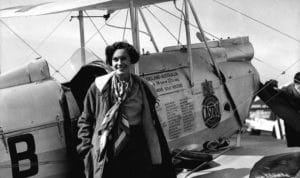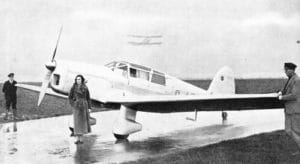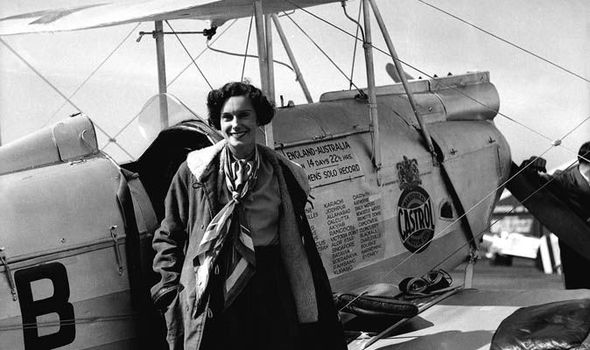High above the arrivals hall in Auckland’s international airport is a plane. It looks tiny in the cavernous, reverberating terminal – merely a decorative prop. But this is the plane that flew from England to Brazil in 1935, and England to New Zealand in 1936, both record-breaking achievements. And today is the birthday of its pilot, Jean Batten.
When Jane Gardner Batten (always known as “Jean”) was born in Rotorua in 1909, her mother pinned a picture clipped from a newspaper to the wall over her daughter’s cot. The grainy image was of a moustachioed man standing beside an aeroplane, a fragile-looking device made of wood and fabric, and the occasion was newsworthy indeed. Frenchman Louis Bleriot had just flown this skeletal contraption across the English Channel “at tremendous speeds” the NZ Herald reported, “far in excess of forty miles per hour”. Jean’s mother Ellen regarded Bleriot’s flight as symbolic of the new world that her daughter was born into, an age where the sky was literally the limit. A headstrong woman with feminist views, she instilled in Jean the dictum that women could accomplish anything a man could.
The family moved to Auckland before Jean reached school age, and in her teen years she apparently showed promise as a concert pianist and ballerina. Instead, in 1927 – the year that Lindbergh flew solo across the Atlantic – she began to obsess about becoming a pilot. It was an era of aeronautical daredevillery, endurance and technological progress, and pilots were the astronauts of their day. The risk was high, but those who were successful were treated as heroes and celebrities. Holidaying in Sydney at age 20, Ellen wangled a flight for Jean with Australian Charles Kingsford-Smith in his plane Southern Cross, in which he had recently made Trans-Pacific, then Trans-Tasman flights. Kingsford-Smith had two pieces of advice for her: “Don’t attempt to break men’s records, and don’t fly at night”. This must have been a red rag to a bull, if not for Jean then at least for her mother.


Her next accomplishment in the Gull was a record-breaking solo flight from England to New Zealand in 1936, and the following year set yet another record for a gruelling Australia to England marathon. But when WWII broke out her beloved Gull was requisitioned by the British Air Force, and she simply gave up flying.
Jean’s heyday was the 1930’s, where for a few years she was a famous, beautiful, determined and fearless aviatrix. The sad truth is that her boundless success was paralleled by a series of personal tragedies; many of her friends, mentors and lovers died, often in planes. She retired from her social circles, living in Europe with Ellen, and was for a while referred to by the press as reclusive – “the Garbo of the Skies” – until she wasn’t referred to at all. Living on the island of Majorca, Spain, she was bitten by a dog in November 1982 and declined medical attention, dying alone in her apartment. Her name meant nothing to the local authorities, and she was buried almost two months in a communal grave with about 150 others. Her family in New Zealand were not contacted, and only years later did they manage to trace her whereabouts. By then, identifying her remains in the mass grave was out of the question, so she remained where she had been anonymously laid to rest.
Happy birthday, Jean Gardner Batten.



